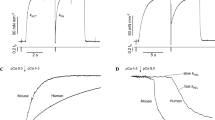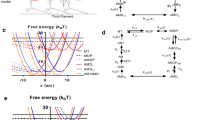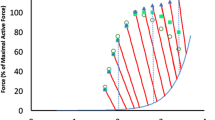Abstract
We examined the tension responses to ramp shortening and lengthening over a range of velocities (0.1–5 L 0/s) and at 20°C and 30°C in tetanized intact fibre bundles from a rat fast (flexor hallucis brevis) muscle; fibre length (L 0) was 2.2 mm and sarcomere length ∼2.5 μm. The tension change during ramp releases as well as ramp stretches showed an early transition (often appearing as an inflection) at 1–4 ms; the tension change at this transition and the length change at which it occurred increased with velocity. A second transition, indicated by a more gradual reduction in slope, occurred when the length had changed by 14–28 nm per half-sarcomere; the tension at this transition increased with lengthening velocity towards a plateau and it decreased with shortening velocity towards zero tension. The velocity dependence of the time to the transitions and the length change at the transitions showed some asymmetries between shortening and lengthening. Based on analyses of the velocity dependence of the tension and modelling, we propose that the first transition reflects the tension change associated with the crossbridge power stroke in shortening, or with the reversal of the power stroke in lengthening. Modelling shows that the reduction in slope at the second transition occurs when most of the crossbridges (myosin heads) that were attached at the start of the ramp become detached. After the second transition, the tension reaches a steady level in the model whereas the tension continues to increase during lengthening and continues to decrease during shortening in the experiments; this continuous tension change is seen at a wide range of initial sarcomere lengths and when active force is reduced by the myosin inhibitor, BTS. The continuous tension decline during shortening is not abolished by caffeine, but the rate of decline is reduced when the active force is depressed by BTS. We propose that stiffening of non-crossbridge visco-elastic elements upon activation contributes to the continuous tension rise during lengthening and the release of such tension and Ca-insensitive deactivation contribute to the tension decline during shortening in muscle fibres.













Similar content being viewed by others
References
Asmussen G, Marechal G (1989) Maximal shortening velocities, isomyosins and fibre types in soleus muscle of mice, rats and guinea-pigs. J Physiol 416:245–254
Bagni MA, Cecchi G, Colombini B, Colomo F (2002) A non-cross-bridge stiffness in activated frog muscle fibers. Biophys J 82:3118–3127
Bagni MA, Cecchi G, Colombini B, Colomo F (2005) Crossbridge properties investigated by fast ramp stretching of activated frog muscle fibres. J Physiol 565:261–268
Bressler BH (1985) Tension responses of frog skeletal muscle to ramp and step length changes. Can J Physiol Pharmacol 63:1617–1620
Cecchi G, Colomo F, Lombardi V (1978) Force-velocity relation in normal and nitrate-treated frog single muscle fibres during rise of tension in an isometric tetanus. J Physiol 285:257–273
Cecchi G, Colomo F, Lombardi V (1981) Force-velocity relation in deuterium oxide-treated frog single muscle-fibers during the rise of tension in an isometric tetanus. J Physiol 317:207–221
Cheung A, Dantzig JA, Hollingworth S, Baylor SM, Goldman YE, Mitchison TJ, Straight AF (2002) A small-molecule inhibitor of skeletal muscle myosin II. Nature Cell Biol 4:83–88
Colomo F, Lombardi V, Piazzesi G (1986) A velocity-dependent shortening depression in the development of the force-velocity relation in frog muscle fibres. J Physiol 380:227–238
Coupland ME, Ranatunga KW (2003) Force generation induced by rapid temperature jumps in intact mammalian (rat) skeletal muscle fibres. J Physiol 548:439–449
Curtin NA, Edman KAP (1989) Effects of fatigue and reduced intracellular pH on segment dynamics in isometric relaxation of frog-muscle fibres. J Physiol 413:159–174
Edman KAP (1975) Mechanical deactivation induced by active shortening in isolated muscle fibres of the frog. J Physiol 246:255–275
Edman KAP (1980) Depression of mechanical performance by active shortening during twitch and tetanus of vertebrate muscle fibres. Acta Physiol Sacnd 109:15–26
Edman KAP (1988) Double-hyperbolic force-velocity relation in frog muscle fibres. J Physiol 404:301–321
Edman KAP (2005) Contractile properties of mouse single muscle fibers, a comparison with amphibian muscle fibers. J Exp Biol 208:1905–1913
Edman KAP, Elzinga G, Noble MI (1978) Enhancement of mechanical performance by stretch during tetanic contractions of vertebrate skeletal muscle fibres. J Physiol 281:139–155
Edman KAP, Elzinga G, Noble MI (1981) Critical sarcomere extension required to recruit a decaying component of extra force during stretch in tetanic contractions of frog skeletal muscle fibres. J Gen Physiol 78:365–382
Edman KAP, Elzinga G, Noble MI (1982) Residual force enhancement after stretch of contracting frog single muscle fibres. J Gen Physiol 80:769–784
Edman KAP, Mulieri LA, Scuborn-Mulieri B. (1976) Non-hyperbolic force-velocity relationship in single muscle fibres. Acta physiol scand 98:143–156
Edman KAP, Reggiani C (1984) Redistribution of sarcomere length during isometric contraction of frog muscle fibres and its relation to tension creep. J Physiol 351:169–198
Edman KAP, Tsuchiya T (1996) Strain of passive elements during force enhancement by stretch in frog muscle fibres. J Physiol 490:191–205
Eklund MC, Edman KAP (1982) Shortening induced deactivation of skinned fibres of frog and mouse striated muscle. Acta Physiol Scand 116:189–199
Elmubarak MH, Ranatunga KW (1984) Temperature sensitivity of tension development in a fast-twitch muscle of the rat. Muscle Nerve 7:298–303
Flitney FW, Hirst DG (1978) Crossbridge detachment and sarcomere ‘give’ during stretch of active frog’s muscle. J Physiol 276:449–465
Ford LE, Huxley AF, Simmons RM (1977) Tension responses to sudden length change in stimulated frog muscle fibres near slack length. J Physiol 269:441–515
Hill AV (1938) The heat of shortening and the dynamic constants of muscle. Proc Roy Soc Lond B 126:136–195
Huxley AF, Simmons RM (1971) Proposed mechanism of force generation in striated muscle. Nature 233:533–538
Jewell BR, Wilkie DR (1958) An analysis of the mechanical components in frog’s striated muscle. J Physiol 143:5151–540
Joyce GC, Rack PM (1969) Isotonic lengthening and shortening movements of cat soleus muscle. J Physiol 204:475–491
Joyce GC, Rack PM, Westbury DR (1969) The mechanical properties of cat soleus muscle during controlled lengthening and shortening movements. J Physiol 204:461–474
Julian F, Morgan D (1979) The effect on tension of non-uniform distribution of length changes applied to frog muscle fibres. J Physiol 293:379–392
Kawai M, Kido T, Vogel M, Fink RHA, Ishiwata S (2006) Temperature change does not affect force between regulated actin filaments and heavy meromyosin in single-molecule experiments. J Physiol 574:877–887
Labeit D, Watanabe K, Witt C, Fujita H, Wu Y, Lahmers S, Funck T, Labeit S, Granzier H (2003) Calcium-dependent molecular spring elements in the giant protein titin. PNAS 100:13716–13721
Lombardi V, Piazzesi G (1990) The contractile response during steady lengthening of stimulated frog muscle fibres. J Physiol 431:141–171
Lymn RW, Taylor EW (1971) Mechanism of adenosine triphosphate hydrolysis by actomyosin. Biochem 10:4617–4624
Månsson A (1994) The tension response to stretch of intact skeletal muscle fibres of the frog at varied tonicity of the extracellular medium. J Muscle Res Cell Motil 15:145–157
Moos C (1981) Fluorescence microscope study of the binding of added C protein to skeletal muscle myofibrils. J Cell Biol 90:25–31
Morgan DL (1994) An explanation for residual increased tension in striated muscle after stretch during contraction. Exp Physiol 79:831–838
Morgan DL, Clafflin DR, Julian FJ (1991) Tension as a function of sarcomere length and velocity of shortening in single skeletal muscle fibres of the frog. J Physiol 441:719–732
Mutungi G, Ranatunga KW (2000) Sarcomere length changes during end-held (isometric contractions in intact mammalian (rat) fast and slow muscle fibres. J Muscle Res Cell Motil 21:565–575
Mutungi G, Ranatunga KW (2001) The effects of ramp stretches on active contractions in intact mammalian fast and slow muscle fibres. J Muscle Res Cell Motil 22:175–184
Offer G, Moos C, Starr R (1973) A new protein of the thick filaments of vertebrate skeletal myofibrils. Extraction, purification and characterization. J Mol Biol 74:653–676
Piazzesi G, Francini F, Linari M, Lombardi V (1992) Tension transients during steady lengthening of tetanized muscle fibres of the frog. J Physiol 445:659–711
Pinniger GJ, Bruton JD, Westerblad H, Ranatunga KW. (2005) Effects of a myosin-II inhibitor (N-benzyl-p-toluene sulphonamide, BTS) on contractile characteristics of intact fast-twitch mammalian muscle fibres. J Mus Res Cell Motil 26:135–141
Pinniger GJ, Ranatunga KW, Offer GW (2006) Crossbridge and non-crossbridge contributions to tension in lengthening muscle: force-induced reversal of the power stroke. J Physiol 573:627–643
Ranatunga KW (1984) The force-velocity relation of rat fast- and slow-twitch muscles examined at different temperatures. J Physiol 351:517-529
Rassier DE, Herzog W, Pollack GH (2003) Stretch-induced force enhancement and stability of skeletal muscle myofibrils. Adv Exp Med Biol 538:501–515
Roots HR, Ranatunga KW (2005) Tension responses to ramp shortening in tetanized intact rat muscle fibres. J Physiol 567P:123P
Roots HR, Ranatunga KW (2006) Tension responses to ramp shortening in tetanized rat muscle fibres: effects of caffeine. Proc Physiol Soc 3:PC103
Shaw MA, Ostap EM, Goldman YE (2003) Mechanism of inhibition of skeletal muscle actomyosin by N-benzyl-p-toluene sulfonamide. Biochemistry 42:6128–6135
Stienen G, Versteeg P, Papp Z, Elzinga G (1992) Mechanical properties of skinned rabbit psoas and soleus muscle fibres during lengthening: effects of phosphate and Ca2+. J Physiol 451:503–523
Sugi H, Tsuchiya T (1988) Stiffness changes during enhancement and deficit of isometric force by slow length changes in frog skeletal muscle fibres. J Physiol 407:215–229
Telley A, Denoth J, Ranatunga KW (2003) Inter-sarcomere dynamics in muscle fibres: a neglected subject? Adv Exp Med Biol 538:481–500
Telley A, Stehle R, Ranatunga KW, Pfitzer G, Stüssi E, Denoth J (2006) Dynamic behaviour of half-sarcomeres during and after stretch in activated psoas myofibrils: sarcomere asymmetry but no “sarcomere popping. J Physiol 573:173–185
ter Keurs HE, Luff AR, Luff SE (1984) Force-sarcomere-length relation and filament length in rat extensor digitorum muscle. Adv Exp Med Biol 170:511–525
Acknowledgements
We thank The Wellcome Trust for the support of our research and Professor Paul Edman (University of Lund, Sweden) for helpful suggestions on the work and comments on the manuscript.
Author information
Authors and Affiliations
Corresponding author
Rights and permissions
About this article
Cite this article
Roots, H., Offer, G.W. & Ranatunga, K.W. Comparison of the tension responses to ramp shortening and lengthening in intact mammalian muscle fibres: crossbridge and non-crossbridge contributions. J Muscle Res Cell Motil 28, 123–139 (2007). https://doi.org/10.1007/s10974-007-9110-0
Received:
Accepted:
Published:
Issue Date:
DOI: https://doi.org/10.1007/s10974-007-9110-0




